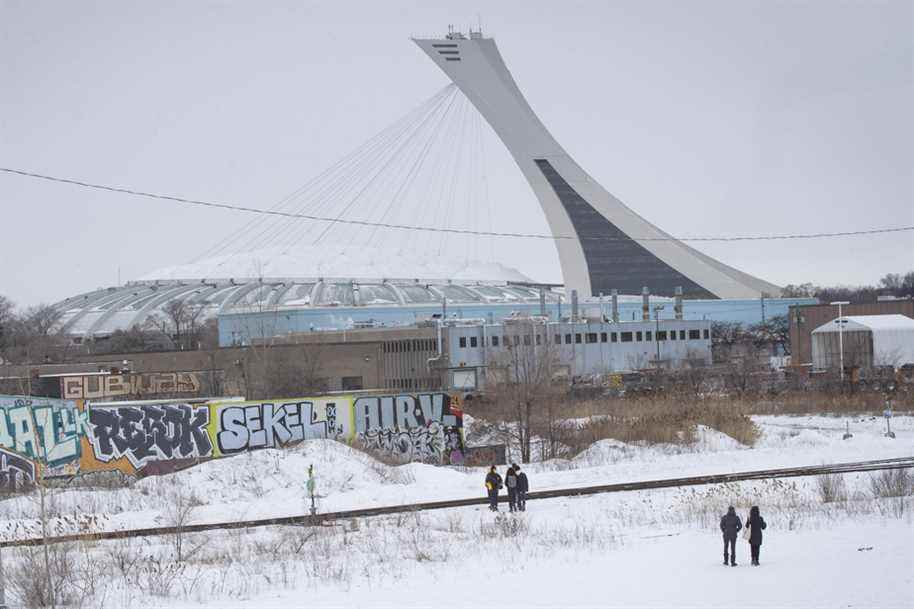More asphalt in exchange for fewer trucks? It’s the offer that’s dividing residents of Montreal’s east end these days, as the extension of trucking routes through a brownfield site is once again being considered.
Posted at 5:00 a.m.
The City of Montreal and the Government of Quebec want to extend avenue Souligny and boulevard de l’Assomption, very close to the Olympic Stadium, in order to divert heavy goods vehicles from the rest of the road network. Some 2,500 trucks leave the Port of Montreal every day, which operates a terminal nearby.
But citizens fear that the diversion of truck traffic, in particular to relieve rue Notre-Dame, will be at their expense. May the fragile balance between industry and neighborhood life, already in danger in this corner of Montreal, be completely reversed.

PHOTO PATRICK SANFAÇON, THE PRESS
Some 2,500 trucks leave the Port of Montreal every day, which operates a terminal nearby.
They observe with suspicion the proliferation of projects in the same formerly industrial area, located between Viauville and Mercier: the Ray-Mont Logistique transshipment site is being built there, Hydro-Québec would like to build a transformer station there and the REM ‘Est will pass there. In addition to the extension of avenue Souligny and boulevard de l’Assomption.
“It adds to the nuisances in an area that is full of nuisances,” argued Cassandre Charbonneau, spokesperson for the Mobilization 6600 group. The group was created to oppose the Ray-Mont Logistique project, but is interested also to the extension of trucking routes.

PHOTO PATRICK SANFAÇON, THE PRESS
Cassandre Charbonneau, spokesperson for the Mobilization 6600 group
Clearly removing trucks from Viau Street is a good idea. But is it absolutely necessary to go in the direction of the growth of the port, when you think of the next 50 years with what is to come [avec les changements climatiques] ?
Cassandre Charbonneau, spokesperson for the Mobilization 6600 group
Multiple projects
The activist climbs the embankment of the Ray-Mont Logistique site to observe the huge area, already scarred by a railway line.
At its feet, the future transhipment platform installed on the site of a steel foundry closed 20 years ago. To the northwest, the Steinberg wood, eyed by Hydro-Québec. To the east, the strip of land that the REM de l’Est would use to climb north, after having accompanied Rue Notre-Dame. To the south, the Port of Montreal’s Viau terminal, inaugurated in 2016.

PHOTO PATRICK SANFAÇON, THE PRESS
A proliferation of projects in the same formerly industrial zone, located between Viauville and Mercier, has been observed.
It is to better channel the flow of trucks going to this terminal (and to the others) that the authorities want to extend the two arteries, indicated the minister responsible for the Metropolis, Chantal Rouleau, in a short interview.
“We want to remove trucks from Notre-Dame Street. There is a huge amount of work being done between the different parties to make this a project acceptable to everyone in terms of integration,” she said.
The City, Hydro-Québec, the Ministry of Transport, the Port of Montreal, everyone talks to set up this project.
Chantal Rouleau, Minister responsible for the Metropolis
Mme Rouleau indicated that the final layout of the new roads had not been decided. It is not known, in particular, whether the new section of boulevard de l’Assomption will reach rue Notre-Dame. A project that called for the construction of an elevated loop was officially abandoned in 2019.
Already, the Port of Montreal has launched the construction of a 33 million overpass over Notre-Dame Street, in order to connect the Viau overpass to the possible road extension. The Port of Montreal refused the interview request of The Press.
“Context not clear”
At the last meeting of the municipal council, the person in charge of Transport of the City was bombarded with questions on the road project. Sophie Mauzerolle worked to defend the approach of the municipal administration in this project.
“We are completely sensitive to your concerns, to your needs. Needs for opening up, but also needs for greening,” she said in response to a citizen, among several others. Mme Mauzerolle refused the interview request of The Press for the file.
The elected official clarified that it was “a not obvious context, where there are really a lot of actors and where we do not have the land control of the land”.
Several of the questions to Mme Mauzerolle had been submitted by activists from Mobilization 6600, the group of Mme Charbonneau.
Such a project, “it changes the landscape, it changes the quality of the air”, lamented Cassandre Charbonneau. “Experience shows that when we create new roads, it relieves a certain time and afterwards, there is just more traffic. »
On the embankment, the activist is approached by a small group of students from the Collège de Maisonneuve, located quite close. They came to see with their own eyes the state of the area and want to get involved.

PHOTO PATRICK SANFAÇON, THE PRESS
Students of Maisonneuve College
“We became aware of what was happening about three weeks ago. I don’t live far away and we go to the local CEGEP. We are really concerned by the fact that there are many citizens whose living conditions will be absolutely ruined by these projects,” said Anne Montplaisir, from the Cégep’s environmental committee.
After a few minutes of observation, the small group descends the steep embankment, a balancing act to avoid falling. On the left, residences. On the right, industrial projects.

